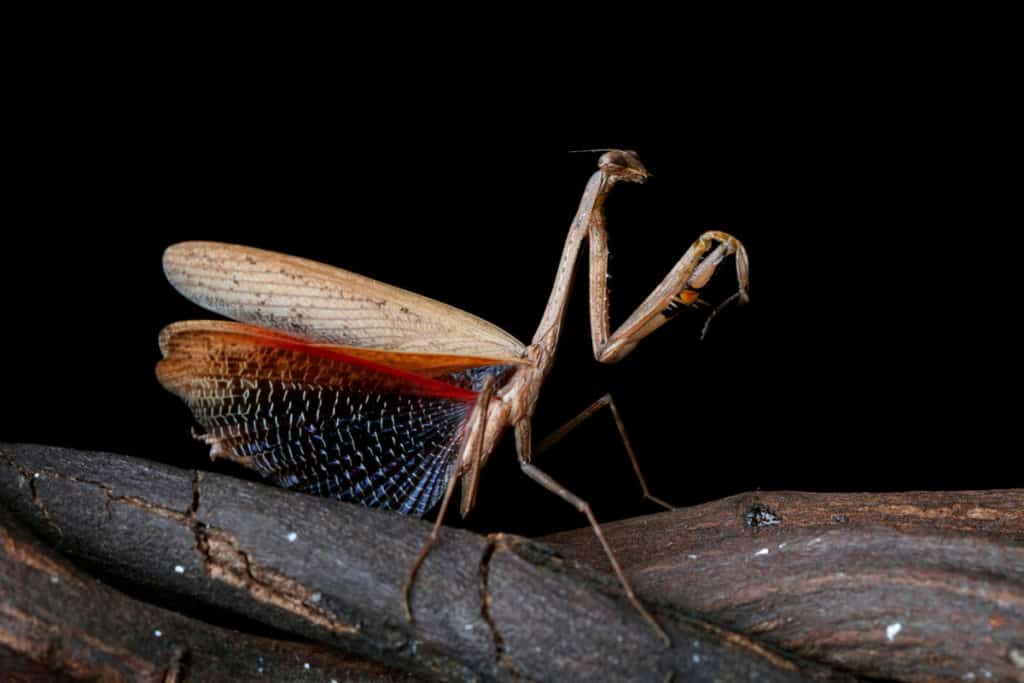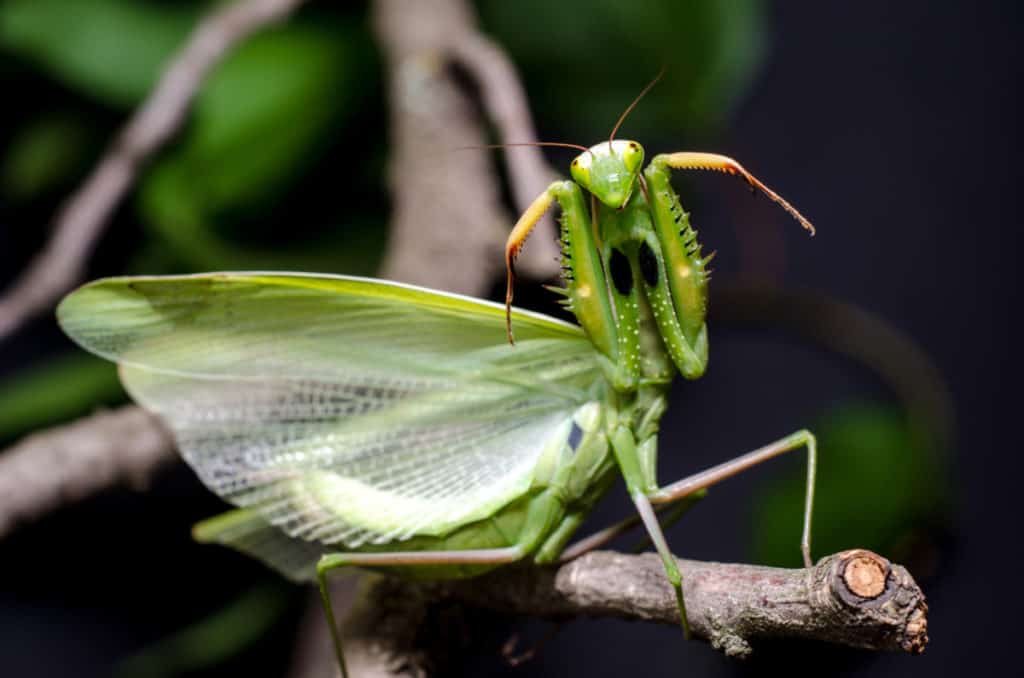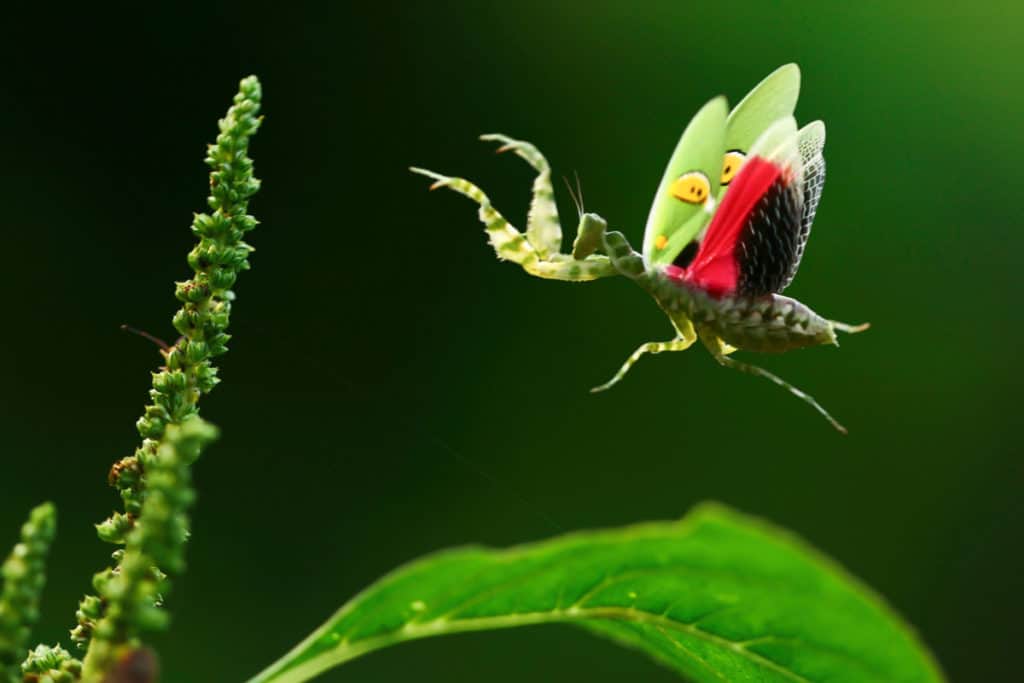Named for its bent front legs, held together in a prayer position, the praying mantis is a fascinating creature well known for its exceptional jumping ability.
But what about flying?
Do praying mantis have wings and can they fly?
Praying mantises have wings which makes it possible for them to fly. However, it depends on the species, developmental stage, gender, and even the weight of the insect. Female mantises usually don’t fly even though they have wings. Young mantises and mantises belonging to some species are wingless.
While praying mantises can fly, most of them are rather clumsy in doing so. The truth is, these insects do a far better job at leaping than flying. Unlike many insects, mantises can jump from point A to B in the blink of an eye.
Read on to find more about how praying mantises fly, the reasons why they fly, and how well these fascinating insects can fly.
Praying Mantis Anatomy
Like any other adult insect, praying mantises have three main body parts: head, thorax, and abdomen.
Mantises have triangular heads, two compound eyes, three simple eyes, and a pair of antennae. They also have a beak-like snout, mandibles, and a very flexible neck. Some species can rotate their heads even up to 180°.
The thorax is divided into three parts: the prothorax, mesothorax, and metathorax. Prothorax, consisting of the head and the forelimbs, remains the most flexible, whereas the mesothorax and metathorax are nearly immobile.
The spiked forelegs of mantises, called the raptorial legs, are a feature unique to these insects, used to grasp and catch prey and to hold it securely.

Their front legs are bent and curled up in a prayer position. This is how these creatures got the name “praying mantises”.
In the days of yore, mantises were considered to be a sign of good luck and prosperity. Some people even believed that God manifests Himself in the form of a praying mantis.
Based on the size of wings, mantises can be divided into several categories, long-winged (macropterous), short-winged (brachypterous), or wingless (apterous). Some species have vestigial wings and they are referred to as being micropterous.
Why Do Praying Mantis Have Wings?
Most mantises have two sets of wings: the outer wing and the hind wing. The outer wing is leathery while the hind wing is thin and delicate.
The outer wing provides protection to the hind wings and functions as camouflage. It is an extension of the exoskeleton and is quite strong and leathery. When a mantis encounters its predator, it uses camouflage and blends into the natural surroundings.
Furthermore, when mantises feel threatened, they usually fan out their leathery outer wings as wide as possible to scare away the predator. The wings help mantises seem dominant and aggressive to their enemies.

The hind wings are lightweight and delicate and are mainly used for flight.
How Well Do Praying Mantis Fly?
Even though most of the mantises come with wings, it does not necessarily mean that all of them can fly. How well mantises fly depends on the species, gender, developmental stage, and even the weight of the insect.

Females are generally larger than males and have shorter wings, allowing them to fly only for short distances.
Young mantises are wingless, hence, cannot fly. They leap from one place to another. During the flight, mantises move their head and back forth. This is believed to be an adaptation to land perfectly on a specific target.
The mantises are more of leaping insects. They can jump long distances in the blink of an eye. They even rotate mid-air to ensure that they land exactly on the target. The fastest praying mantis can move at a speed of 730 millimeters per second.
Can All Praying Mantis Fly?
Some adult species, as well as young mantises of all species, are wingless, so all they can do is leap to move from one place to another.
Male praying mantises usually fly from place to place. They can sense the pheromones female mantises emit when it is time to mate. Once males sense the pheromone, they fly towards the female mantis for mating. Sexual cannibalism is seen in praying mantises, where females eat their mates after copulation.
Adult females usually lay eggs in autumn and die soon after. The eggs normally hatch in the spring and are protected till then by their hard capsules.
How Fast Do Praying Mantises Fly?
According to recent research, the fastest praying mantises can move at 730 millimeters per second. However, this incredible speed applies more to jumping, rather than flying.
Researchers have used slow-motion videos to describe how exactly the praying mantises jump from point A to point B in less than the blink of an eye.
Once the ferocious insect fixes their eyes on a target, they move their heads back and forth as if judging the distance from the target and their position. After successfully measuring the distance they pounce on the target by wiggling their body back and forth and curling their abdomen to adjust their center of mass.
Finally, they take off. But before they land, the leafy green predators rotate mid-air in a spin to make sure that the whole body stays on target. Once they land on the prey, they use their raptorial legs to grasp the prey and kill it, usually by biting the heads of their victim.
Now you know mantises do more than just leaping from point A to point B.
Frequently Asked Questions
Are Praying Mantis Aggressive?
Although they can leap with a speed of light and are considered cold-blooded predators, praying mantises are not aggressive in nature and do not pose any threat to humans.
They are ambush predators; they sit and wait for their prey and use their raptorial legs to grasp it if it comes near.
How Long Do Praying Mantis Live?
The lifespan of praying mantises depends on the species. Smaller species of mantis roughly live for 4 to 8 weeks, whereas the larger species can live up to 6 months. The adult females after laying eggs usually die in autumn after laying eggs.
Do Praying Mantis Make Good Pets?
Praying mantises can be fun pets as it is simple and fun to take care of them. But the natural habitat of these insects includes tropical and temperate areas, so make sure you keep the mantis in a cool place. However, the temperature should not be too low as this will result in the death of the mantis. Altogether, praying mantises are suitable for insect hobbyists and even for beginners.
What Do Praying Mantis Eat?
Praying mantis feed on most pests, predominantly spiders, crickets, grasshoppers, and butterflies. Mantises have an increased appetite due to which they are beneficial for farmers in terms of getting rid of crop-eating pests. Mantises do not feed on crops, leaves, or plants.
If you are interested we have two articles on the diets of praying mantis covering both nymphs and adults. The articles are linked below:
What Do Baby Praying Mantis Eat?
What Do Praying Mantis Eat? (With Video Hunting A Fish)
The Wrap Up
Though praying mantises are known for their jumping ability, these insects have wings and can fly. However, there are exceptions. Females do not fly as they have short wings and are heavy when compared to males. Young mantises and mantises belonging to some species do not fly as they are wingless.
As praying mantises can leap from one point to another so quickly, they are considered to be dangerous. But the truth is, praying mantises do not harm humans. Although they bite when triggered, their bite or sting is not dangerous to humans.
One benefit of praying mantises worth mentioning is their appetite. These insects help farmers tremendously by eating mosquitoes, flies, and moths. It sure plays a role in maintaining the ecological balance.
There are a bunch of interesting bugs that can fly. If you are interested we have some other articles about them. Check out the articles we have written below:
How Fast Can Wasps Fly And Can You Outrun Them?
How Do Bees Fly? They Are Heavy Lifting Marvels
Can Bumblebees Fly in the Rain?
Sources
https://www.keepinginsects.com/praying-mantis/general/
https://praying-mantis.org/can-praying-mantis-fly/
https://explorationsquared.com/do-praying-mantises-fly/
https://en.wikipedia.org/wiki/Ambush_predator
https://www.nytimes.com/2020/05/14/science/praying-mantis-strike.html
https://royalsocietypublishing.org/doi/10.1098/rsbl.2020.0098
